Home | Trends | Manure Management | Nutrients | Water Quality (You are here) | Clean Water Act | Stewardship | Conservation | Conservation Practices
Many of the images and scenarios on this page may be permit violations or may contribute to exceedances of water quality standards; however, additional information beyond what is provided on this educational page is required to make determinations of that nature. The next topic in this module provides additional information on Clean Water Act requirements.
Challenges In Managing Manure Nutrients
Nitrogen (N) and phosphorus (P) are essential for plant growth. When nutrients are applied in excess of what crops need or when they are applied at a risky time, more nutrients can end up in water than might otherwise have been the case. This holds true regardless of the source of nutrients. This module focuses on manure and some of the challenges in managing manure nutrients.
Economics. Manure contains more than nutrients. Organic matter contributes to soil health and crop growth. Manure also contains water. “Dry” solid manure can be 20-40% water and manure pumped from a liquid or slurry storage is about 90% water. Nutrients in manure are less concentrated than in commercial fertilizers. Relatively speaking, that makes manure expensive to haul long distances. As animal agriculture sectors have consolidated, resulting in larger farms, more manure is produced in smaller areas. Because of the transport expense, manure tends to be applied close to where it is produced.
In areas with many livestock or poultry farms exporting manure, it can be challenging to find fields within a reasonable distance for application. Farmers are beginning to do more manure marketing and some are looking at technologies that can add value to manure. These can offset the costs of transporting manure or can transform manure nutrients into a form that is economical to transport. Related: USDA Economic Research Service “Effects of structural change: manure and excess nutrients” (dairy). The referenced chapter is part of a larger report.
Nitrogen:Phosphorus Ratio. Another important point regarding manure is that it contains more P than N relative to what crops need. If manure is applied at rates to meet the crop N needs, more P than the crop can use in a single year is applied. Over time, P in the soil can build up to levels that present a significant risk for transport to water. Managing this, at least in part, includes a process known as nutrient management planning.
Another way to manage this risk is through the use of the phosphorus index (P-index). The P-index is a risk assessment that factors in several inputs to determine if N-based rates of manure can be used or if application needs to be reduced to a P-based rate. In some cases, the index may show a high enough risk to discontinue P application (manure or otherwise) altogether. To learn more about the P-index, do an Internet search with your state name + phosphorus index. Recommended Resource: SERA-17 publications.(a multistate information exchange group focused on P.)
Variable Nutrient Content. Manure is not a standard product. It varies greatly among animal species and even within species due to varying farm management practices. The most accurate estimate of a farm’s manure nutrient content comes from sampling and manure testing. Recommended Viewing: Iowa Learning Farms videos on liquid manure and solid manure sampling procedures.
Nitrogen Availability. Much of the nitrogen in manure is in organic form. This type of nitrogen is not plant-available (more below) and is slowly mineralized by soil microbes into plant-available forms over several years. The rate at which this mineralization happens is dependent on temperature, moisture, and soil microbial activity, all of which cannot be predicted exactly. Extensive research has led to state-specific recommendations for estimating the amount of nitrogen that will be available to plants each year from manure and other organic sources. Most state Extension services have publications available on this topic.
Recommended Reading: Nitrogen Management on U.S. Corn Acres 2001-10 (USDA Economic Research Service). See Table 3 “Share of treated corn acres that did not meet rate, timing, and method criteria by N source” for data illustrating the challenges of nutrient management and manure.
What Happens When Manure Nutrients Reach Surface Water?
Nutrients, including N and P, are necessary for plant and animal life in streams, lakes, and other surface water bodies; however, a large influx of N, P, or both moves the system out of balance. This enrichment is known as eutrophication.
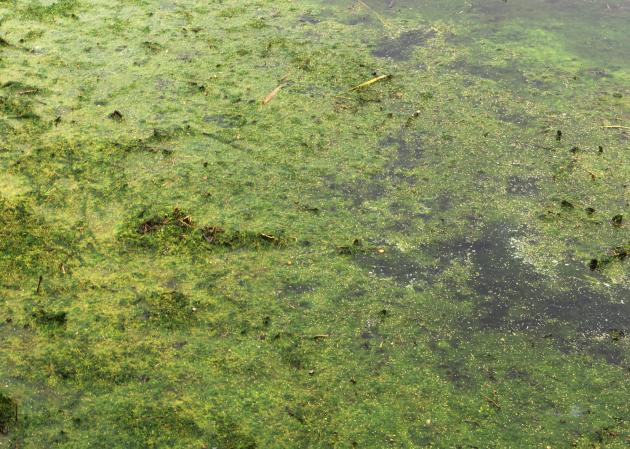
Photo 1. (Above) Algae is beginning to grow in earnest as the water warms up in late spring.
Aquatic plants and algae grow rapidly under eutrophic conditions (Photo 1). When the algae or plants die, the decomposition process depletes oxygen dissolved in the water, a condition known as hypoxia. Without adequate oxygen, fish, shellfish, and other aquatic life die or move to non-hypoxic areas. Another concern is that certain types of algae release toxins that can be harmful to people, pets, or livestock. Excessive algae growth, toxic or not, is referred to as a harmful algal bloom.
Hypoxic zones are an environmental problem, as well as an economic one, as large areas may become unsuitable for commercial fishing, shrimping, and similar activities. The sources responsible for nutrient releases into water vary for each watershed, but usually include agriculture as well as municipal wastewater treatment, urban stormwater, residential areas, and others.
Manure Nutrients in Groundwater
Groundwater is the primary source of drinking water in many parts of the country. The U.S. Environmental Protection Agency (EPA) has set 10 parts per million (ppm) of nitrate (NO3–) as the maximum level considered safe for drinking water.
High nitrates occur in surface water as well as groundwater, but are most often discussed as a risk for groundwater because of the large number of private, rural groundwater wells used for drinking water. Municipalities that use surface or ground water for drinking are required to test for nitrates and take corrective action if levels are above allowable limits.
How Do Nutrients Reach Water?
Nutrients are mobile. They cycle and transform in the environment. Even perfectly managed manure handling systems cannot expect to contain 100% of the N and P. Losses can be held to acceptable levels through management and conservation practices. Nutrients from crop fields reach water sources in one of two ways, runoff or leaching. Nutrient runoff occurs when nutrients dissolve in water that flows over the soil surface or when water carries particles of soil containing nutrients to a stream, river, lake, ocean or other surface water. Nutrient leaching occurs when nutrients dissolve in water that is flowing downward through the soil profile.
Nitrogen
Manure N is mostly in organic form with a lesser amount of inorganic ammonia. The amount of each varies greatly depending on the animal species and manure collection and storage practices. Once applied to a crop field, a complex network of chemical and biological processes, referred to as the nitrogen cycle, takes over. Organic N from sources like manure or crop residue is mineralized to ammonium (NH4+) and eventually nitrate (NO3–).
Organic N and NH4+ are more likely to be associated with soil particles or soil aggregates and may be carried with eroded soil in runoff to surface water bodies. High ammonia levels in surface water are detrimental to aquatic organisms.
Nitrate is soluble and can be carried with runoff or leach downward through the soil profile. When NO3– is carried down below the root zone, it can no longer be captured by plants and used for crop or grass growth. This puts groundwater resources at risk for contamination. Ammonium (NH4+) or organic N are not generally viewed as a risk for leaching.
Phosphorus
Phosphorus also cycles through organic and inorganic forms and all, or nearly all, P applied through manure is considered available to plants. Unlike NO3–, P binds tightly to soil particles. Rain events capable of eroding soil particles are likely to carry P along with the runoff. To a much lesser extent, P can be soluble (dissolved in water) and carried in runoff, especially when soil P builds up to very high levels. Most P is carried to surface water bodies along with soil.
Phosphorus is not generally a significant leaching risk because of its tight bond to soil particles. There are a few situations, such as soils that are saturated with P or where subsurface (tile) drainage is used, where the risk of P leaching may be substantial.
Recommended Reading: Manure Chemistry: Nitrogen, Phosphorus, and Organic Matter (U.S. Department of Agriculture Natural Resources Conservation Service).
What Are the Risks Associated with Manure and Water Quality?
When it comes to manure nutrients and land application, proper management is critical.
Farm Site Risks
Around the farm site, manure collection and storage as well as uncontained runoff from open lots are the primary risk areas for manure releases or discharges to water (Photos 2 and 4, below). Many states have rules that require minimum distances between manure storage structures and water, wells, sinkholes, or other environmentally sensitive areas. These distances are called setbacks. The closer that manure is stored near these features, the greater the risk of contamination.
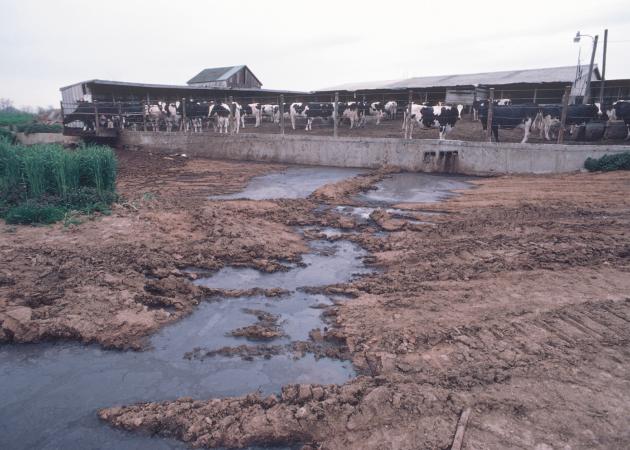
Photo 2. (Above) Uncontrolled feedlot runoff is a risk to water quality. Photo courtesy of U.S. Department of Agriculture Natural Resources Conservation Service (USDA NRCS). Containment systems like those shown in Photos 3 and 5 (below) should be used.
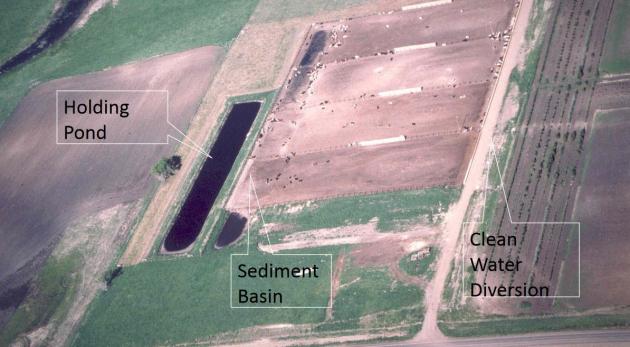
Photo 3. (Above) An example of an open lot feeding operation that not only contains runoff in sediment basins and holding ponds, but also installed a diversion to prevent clean water from entering the feedlot. Photo courtesy of USDA NRCS.
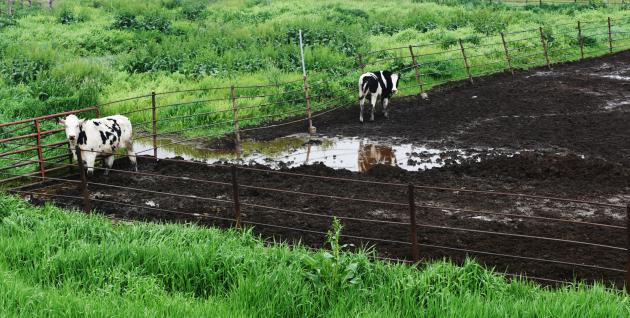
Photo 4. (Above) Water is draining uncontrolled from this lot into the adjacent natural drainage area. Runoff should be managed with appropriate best management practices such as clean water diversions, settling basins, or holding ponds like those shown in Photo 3 (above) or Photo 5 (below).

Photo 5. (Above) This open lot includes a settling basin (or sediment basin) in the foreground. The animal pens are behind the photographer. When solids have settled out, the liquid is allowed to flow through the pipe into the liquid manure storage in the background. The settling basin is designed for easy access for regular removal of the solids. This two-part system increases the storage life of the manure storage structure in the background by preventing a large portion of solids from entering the structure.
Manure storage structures require careful attention to engineering, construction, operation, and maintenance. If any of these aspects are deficient (Photo 6, below), the structure is at risk for failure. Most problems can be prevented by regular inspection and maintenance. Iowa State University analyzed 58 manure incidents in 2007 and “human error” was identified as the most common cause (13 incidents). They cited things like “leaving pumps unattended” and “failure to close valves” as the type of human errors that occur.

Photo 6. (Above) An overflowing manure storage. Photo courtesy of USDA NRCS. Regular inspections and timely removal of manure for land application could have prevented this situation. In some areas, covered manure storage structure structures are recommended to prevent rainfall and snowmelt from contacting the manure.
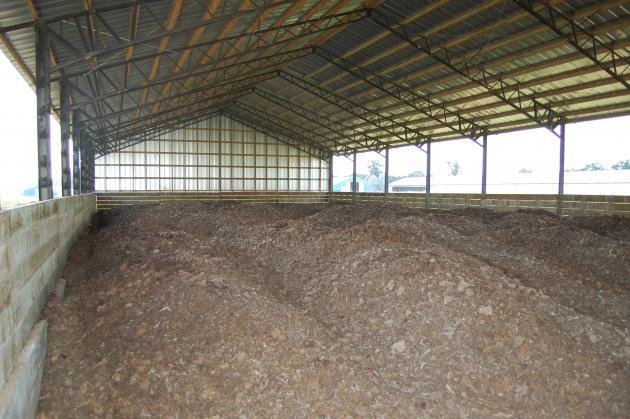
Photo 7. (Above) A poultry litter storage facility that is covered. The roof keeps the litter dry and helps prevent the problem seen in Photo 6. The structure is nearing full capacity and the photo was taken on the day it was emptied and the litter hauled to fields for land application. Photo courtesy of Josh Payne, Oklahoma State University.
In addition to manure storage structure failures, manure discharges or spills can be caused by the failure of pumps, hoses or pipes, valves and other handling equipment. The area where manure is loaded into spreaders or tankers is a common area for spills to occur. These spills should be cleaned up quickly to avoid the potential for runoff and to keep the farm site neat.
Transportation Risks for Manure Spills
Moving manure from the farm to the field on public roadways includes the inherent risks that come with traffic. Collisions and overturned tankers or spreaders can result in manure being released onto roads and into ditches.

Photo 8. (Above) An overturned manure tanker on a public roadway. Photo courtesy Kevin Erb, University of Wisconsin.
Land Application Manure Loss Risks
During manure application, the risks for manure/nutrient losses include:
- Overapplication
- Not observing setbacks
- Poor timing (weather)
Overapplication. Applying too much manure can be the result of incorrect calculations, incorrect settings on the application equipment, or improperly calibrated equipment. Equipment failures can also lead to too much manure being applied to a field or small area of a field. Overapplication also occurs when there is too little available land for the manure that must be applied.
Setbacks. Many states have setbacks that require minimum distances between land application and water, wells, sinkholes, or other environmentally sensitive areas. The closer that manure is applied near these features, the greater the risk of contamination. This is especially true in locations with karst topography. Sinkholes or fractured bedrock provide a direct path for manure to reach groundwater.
Timing. Weather is an especially important factor in application risk. Applying manure to saturated soils or when drainage tile is flowing increases the risk for both surface-applied and injected manure. Field operations under those conditions also leads to soil compaction which is bad for crop yields and can increase the future risk of runoff.
Frozen or snow covered soils prevent manure from contacting the soil or infiltrating into the soil and also limit or prevent incorporation which is necessary to help stabilize applied manure as part of the soil structure thereby reducing runoff potential. As plants are generally not growing in frozen or snow-covered soils, no agronomic uptake of manure nutrients is occurring either. Applying on frozen or snow covered ground is not advisable and, in many cases, not allowed according to state requirements.
Manure application should be avoided if significant rain is predicted, especially for surface-applied manure that will not be incorporated, and should not begin until soil conditions are favorable.
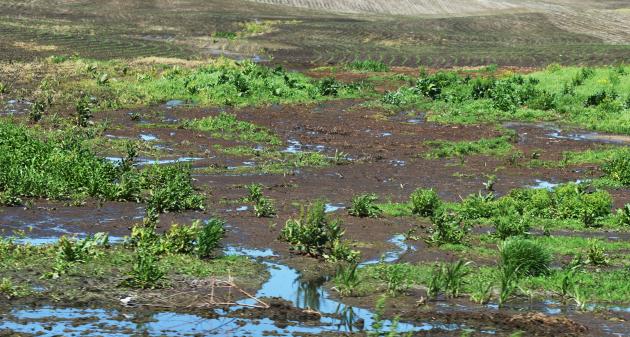
Photo 9. (Above) Manure application immediately preceding a significant rain event is a high pollution risk and should be avoided. Spreading on this field occurred on the same day as a rainfall and manure was carried by runoff to the base of this field. This photo was taken after another rain event approximately two weeks later, showing more runoff with the potential to further carry manure and nutrients offsite. Making a high-risk application was the first mistake. The second mistake was in not cleaning up the solids as soon as field conditions allowed and re-spreading them when rainfall was not expected.
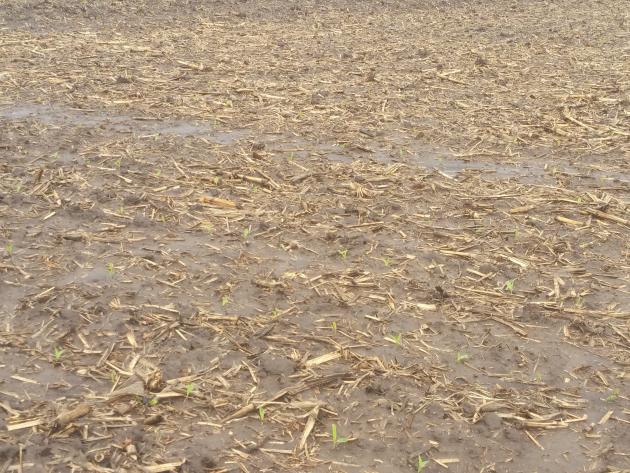
Photo 10. (Above) This was taken the same day as Photo 9 on a field three miles away. The biggest difference is that the manure application (also solid beef feedlot manure) to this field occurred under dry conditions and the manure was lightly incorporated. In the photo, runoff from the rainfall that occurred two weeks after manure application does not appear to be carrying manure from the field; this shows how well the manure was integrated into the soil structure. The manure nutrient runoff risks from this field are much lower than the field in Photo 9.
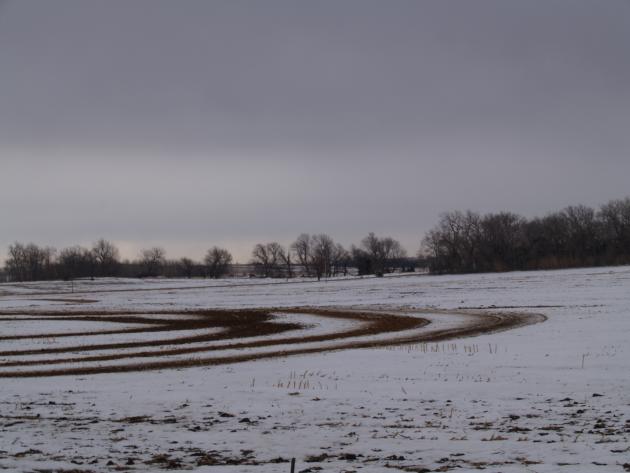
Photo 11. (Above) Manure application to frozen or snow-covered soil should be avoided. Some states prohibit manure application during winter months. Managing manure storage levels so that adequate capacity is available to retain manure during extended periods of high-risk conditions (such as winter) is an important management practice.
Other Potential Water Quality Concerns
This page focuses on nutrients and water quality but there are additional manure-related topics of which you should be aware. The following sections very briefly introduce three of these: pathogens, pharmaceuticals, and organic matter.
Microbes and Pathogens
Microbes that are capable of causing diseases are called pathogens. While pathogens make up only a small portion of the microbial world, they get a lot of the attention. Some of the pathogens associated with animal manure include: Escherichia coli O157:H7, Campylobacter spp., Salmonella, and Listeria. The ways that manure pathogens reach water are largely the same as the way manure nutrients travel to water. Recommended: “Manure pathogens and microbial by-products” and “Best practices for pathogen control in manure management systems“
An example of a watershed impacted by waterborne pathogens, including those associated with manure, is Samish Bay in Washington. The presence of fecal coliforms at high levels in the bay have made the water unsuitable for shellfish production and recreation. Research is being done on the effects of manure treatment, especially composting and anaerobic digestion, on pathogens in manure. Recommended Viewing: Two webcast presentations “Pathogens 101” and “Microbes: From Farm to Public Risk“.
Biochemical Oxygen Demand (BOD)
We previously discussed the ability of manure nutrients to stimulate plant growth in aquatic systems. Once the “bloom” is over and the plant material begins to decay, oxygen is rapidly removed from water and can lead to fish kills or can lead to long-term hypoxic zones. In addition to nutrients, the large amount of organic matter in manure also depletes water of dissolved oxygen if a significant amount of manure reaches the water body. Runoff from silage or feed piles on livestock farms is another waste stream that has a high BOD and should be contained or controlled just like runoff from manure storage or open lots. Recommended reading: Oklahoma State University developed a comprehensive explanation on organic matter in manure and other wastewater and how it interacts with the environment.
Recommended Resources
The video below was produced by the U.S. Poultry and Egg Association in cooperation with the Livestock and Poultry Environmental Learning Center and U.S. EPA. It covers several water quality topics as well as some air quality concerns. Even though the video references poultry production, it is applicable to other species.
Extension Publications
- Agricultural Phosphorus Management: Protecting Production and Water Quality LPES Curriculum Lesson 34
- Manure Spills: What You Need to Know & Environmental Consequences North Dakota State University
- Phosphorus management in pork production eXtension (much of the information is applicable to other animal species as well)
- [Archived webinar] “Manure Spills and Emergency Planning” includes sections on spill causes and case studies, solid manure considerations, and technology to prevent spills.
- [Archived webinar] Nitrates In Groundwater includes research from several states and a presentation on N losses from tile drainage
U.S. Environmental Protection Agency Publications
- Estimated Nitrogen and Phosphorus from Animal Manure (Including estimates on the amount of N and P produced relative to farm land)
- EPA Perspective on Nutrient Pollution (Recorded presentation from Waste to Worth 2013 in Denver, CO)
- Risk Assessment Evaluation for Concentrated Animal Feeding Operations, 2004
- Literature Review of Contaminants in Livestock and Poultry Manure and Implications for Water Quality, 2013
- Managing Manure Nutrients at CAFOs, 2004
- An Urgent Call to Action Report of the State-EPA Nutrient Innovations Task Force (2009)
- Contaminants of Emerging Concern including Pharmaceuticals and Personal Care Products Literature review (2008)
U.S. Geological Survey Publications
- Nutrient Trends in Rivers and Streams of the U.S. 1993-2003
- Nutrients In the Nation’s Streams and Groundwater National Water Quality Assessment Program
The video below was developed by the University of Wisconsin as part of a series of materials for ag educators related to manure nutrient management.
Acknowledgments
Previous: Manure Nutrients and Land Application | Next: Regulatory Requirements
These materials were developed by the Livestock and Poultry Environmental Learning Center (LPELC) with funding from the U.S. Environmental Protection Agency and with input from the Natural Resources Conservation Service, National Cattlemen’s Beef Association, National Milk Producers Federation, National Pork Board, United Egg Producers, and U.S. Poultry and Egg Association.
For questions on these materials, contact Jill Heemstra, jheemstra@unl.edu. All images in this module, unless indicated otherwise, were provided by Jill.
Reviewers: Tetra Tech, Inc.; Joe Harrison, Washington State University; Tom Hebert, Bayard Ridge Group; and Mark Risse, University of Georgia

